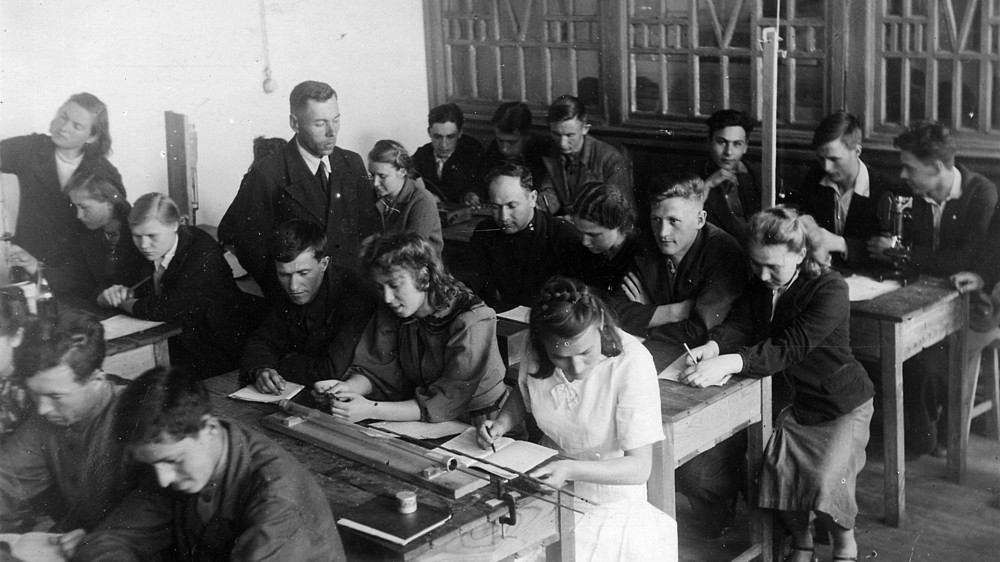
The war had inflicted heavy damage to our country. The builders were faced with the task of restoring everything that was destroyed and deploying new construction as soon as possible. Thousands of LISI (SPbGASU) graduates took part in the creative work on the revival of cities, industrial and agricultural facilities: architects and civil engineers of various specialties, namely industrial and civil engineers, heat and gas supply and ventilation engineers, constructors of roads, bridges and tunnels, design engineers, urban planners, hydraulic engineering.
By a decree of the Presidium of the Supreme Soviet of the USSR dated 29 November, 1945, the Leningrad Civil Engineering Institute was awarded the Order of the Red Banner of Labor for outstanding achievements in the field of training engineering personnel for construction; 36 professors, teachers and employees of the institute were awarded orders and medals.
.png)
The restoration of the national economy required a large number of civil engineers, so the plan for admission to the institute in the post-war period increased annually. In 1945 there were 745 full-time students at the institute, and in 1950 there were already 1536 of them, and in 1955 - 3361. The community of students continued to increase in the future.
For the speedy training of specialists, in the period from 1952 to 1957 there was organized the accelerated training for people who had previously received secondary technical education, lasting 2 years 4 months.
In the first post-war years, the institute was faced with the acute problem of staff recruitment. Before the start of the first post-war academic year, about 150 professors and teachers worked at the institute. During the first academic year after the war, other twenty teachers returned to the institute, among them was Nikolai Khomutetsky, director of the institute in 1948–1952, head of the department of history and theory of architecture in 1955–1972.
In December 1946, the third student scientific conference was held, at which 51 works on topical issues were reported in eight sections. Each of the student conferences, which have since become annual, was timed to coincide with the opening of reporting exhibitions of study groups of drawing and painting, architectural clauses.
The decision adopted in 1948 by the Council of Ministers of the USSR on the provision of scholarships to students who passed all exams and tests with only “good” and “excellent” marks had a positive effect on the educational process, as it stimulated high academic performance.
The university actively helped other construction universities of the USSR and friendly countries. So, in 1948-1949 academic year associate professors, assistants, PhD students of LISI were sent to construction universities in Voronezh, Kuibyshev (Samara), Odessa and Tomsk. Other construction universities and related faculties of polytechnic institutes received significant assistance in improving the educational process.
In February 1949, an educational and methodological meeting of all construction universities in the country was held at LISI. On 20 December, 1951, the first educational and methodological conference of the teaching staff was held at the institute. At five sections on various areas of educational and methodological work, 33 works were reported and detailed decisions were made aimed at significantly improving educational activities.
Representatives of construction, design and scientific institutions of Leningrad, other cities of our country and a number of foreign countries actively participated in the scientific conferences of LISI. In 1951–1952 textbooks were published, which subsequently won well-deserved fame. Among them was "Reinforced Concrete Structures" by Professor Konstantin Sakhnovsky. The institute was cooperating with dozens of construction organizations and industrial enterprises, developed topical scientific problems, provided advice and conducted expert examinations.
Other materials of the "Scientific Regiment" project:
Our Graduate Built the Road of Life
Front Line of the Architect Aleksandr Nikolsky
Researcher who Developed Science in Besieged Leningrad
Fights of Student Klinov
Engineer of the 3rd Belorussian Front
Nineteen-Year-Old Gunner Stormed Berlin
Path of a Volunteer: from Front-Line Roads to Space Development
Ivan Solomakhin: "The Most Memorable Battle was for this Devil's Hill!"
Fiery Dnieper of the Hero of the Soviet Union Aleksandr Prygunov
Approaching to the Victory
Fedor Komal's Front: from the War Start to the Victory
Junior Political Instructor Boris Gubanov: “Shells Were Whizzing, and the Ground Took off Nearby”
Viktor Kvyatkovsky, Radio Reconnaissance Operator of the Baltic Fleet
How the Chief Architect Nikolai Baranov Kept Leningrad "Hidden" from the Enemy
Architect Nikolai Khomutetsky: Four Years at the Forefront
Semyon Shifrin Thwarted Nazi Plans to Leave Leningrad Waterless